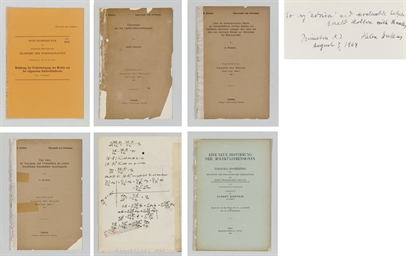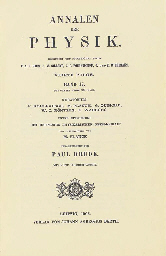EINSTEIN, Albert. A collection of letters to Rudi W. Mandel ON THE CONCEPT OF THE GRAVITATIONAL LENS, comprising: EINSTEIN. Autograph letter signed ("Albert Einstein") to Rudi W. Mandel, incorporating many formulas and equations, [Princeton, N.J.], 2 June 1936. 3 pages, 4to, written on rectos only in dark ink, slight fold separation ; EINSTEIN. Typed letter signed ("A. Einstein"), [Princeton, N.J.], 23 April 1936. 1 page, 4to. ; EINSTEIN. Typed letter signed ("A. Einstein") the text incorporating autograph formulas and equations, [Princeton, N.J.], 12 May 1936. 2 pages, 4to ; EINSTEIN. Autograph letter signed ("A. Einstein"), Princeton, N.J., 23 November 1936. 1 page, on stationery with Einstein's deleted Berlin address ; DUKAS, Helen, Einstein's secretary . Three typed letters signed to Mandl, Princeton, 1 April, 25 May & 28 November 1936. Each 1 page, 4to ; Together 10 pages, 4to , all in German. [ With: ]. MANDL. Typed ms. (carbon) signed, 4 pp., 4to. MANDL. Blueprint diagram, n.d. 1 page, small folio ; EINSTEIN. Printed galley proof of his article "Lens-Like Action of a Star by the Deviation of Light in the Gravitational Field," Science , 1936. 1 page, narrow folio, on proof paper. EINSTEIN CONSIDERS THE THEORY OF GRAVITATIONAL LENSING, ANOTHER EFFECT OF THE GRAVITATIONAL DEFLECTION OF LIGHT Einstein's extensive, thoughtful correspondence with a young German scientist regarding an unusual corollary aspect of Einstein's General Theory of Relativity, the theory of gravitational lensing, which later elicited Einstein's article on the phenomenon: "Lens-Like Action of a Star by the Deviation of Light in the Gravitational Field," in Science , vol. 84 (1936), pp.506-507). Following the historic 1919 Eddington expedition to observe the solar eclipse, which provided prima facie confirmation of the deflection of light by the gravitational curvature of space which Einstein had predicted, another eminent English physicist, Sir Oliver Lodge (1851-1940), suggested the possibility that a massive astronomical object lying directly in the line of sight between a distant star and an observer on the Earth could create gravitational lensing, resulting in multiple images being received by the eye or camera of the observer. The question of the existence of gravitational lensing aroused the curiosity of Rudi W. Mandel, a young German émigré residing in Washington, and he wrote to Einstein and asked if they could meet to discuss the subject. Einstein's secretary, Dukas, in a note dated 1 April 1936, told Mandl that he could meet Einstein at Princeton's Fine Hall, but suggested he write in advance to arrange an appointment. The encounter did take place, as evidenced by Einstein's letter of 2 June which constitutes what he terms his "second thoughts" on gravitational lensing. Mandl countered with additional arguments in support of his theory, and, in a response dated 23 April, Einstein explains that he is now certain that Mandl's idea that ring nebulae might constitute instances of gravitational lensing is erroneous. He adds that while he considers Mandl's theory illogical, the younger man should not be too disappointed, for "in science, you must bury many hopeful-appearing ideas before you stumble upon one which has solid foundations." Einstein, who clearly considered the subject one of interest, marshalled additional equations to prove that such an effect would not be observable in the case of the nebulae, employing clearly defined algebraic symbols to express the radius of a theoretical star, its distance from the observer, its distance from the lensing gravitational object and other concepts. In conclusion, though, he sternly cautions Mandl that his "fantastischen Speculationen," if committed to print, would only earn him scorn and derision from modern astronomers. On March 27, Miss Dukas wrote to Mandl to inform him that Professor Einstein had himself written a brief article on the issue of gravitational lensing, citing his discussions w
EINSTEIN, Albert. A collection of letters to Rudi W. Mandel ON THE CONCEPT OF THE GRAVITATIONAL LENS, comprising: EINSTEIN. Autograph letter signed ("Albert Einstein") to Rudi W. Mandel, incorporating many formulas and equations, [Princeton, N.J.], 2 June 1936. 3 pages, 4to, written on rectos only in dark ink, slight fold separation ; EINSTEIN. Typed letter signed ("A. Einstein"), [Princeton, N.J.], 23 April 1936. 1 page, 4to. ; EINSTEIN. Typed letter signed ("A. Einstein") the text incorporating autograph formulas and equations, [Princeton, N.J.], 12 May 1936. 2 pages, 4to ; EINSTEIN. Autograph letter signed ("A. Einstein"), Princeton, N.J., 23 November 1936. 1 page, on stationery with Einstein's deleted Berlin address ; DUKAS, Helen, Einstein's secretary . Three typed letters signed to Mandl, Princeton, 1 April, 25 May & 28 November 1936. Each 1 page, 4to ; Together 10 pages, 4to , all in German. [ With: ]. MANDL. Typed ms. (carbon) signed, 4 pp., 4to. MANDL. Blueprint diagram, n.d. 1 page, small folio ; EINSTEIN. Printed galley proof of his article "Lens-Like Action of a Star by the Deviation of Light in the Gravitational Field," Science , 1936. 1 page, narrow folio, on proof paper. EINSTEIN CONSIDERS THE THEORY OF GRAVITATIONAL LENSING, ANOTHER EFFECT OF THE GRAVITATIONAL DEFLECTION OF LIGHT Einstein's extensive, thoughtful correspondence with a young German scientist regarding an unusual corollary aspect of Einstein's General Theory of Relativity, the theory of gravitational lensing, which later elicited Einstein's article on the phenomenon: "Lens-Like Action of a Star by the Deviation of Light in the Gravitational Field," in Science , vol. 84 (1936), pp.506-507). Following the historic 1919 Eddington expedition to observe the solar eclipse, which provided prima facie confirmation of the deflection of light by the gravitational curvature of space which Einstein had predicted, another eminent English physicist, Sir Oliver Lodge (1851-1940), suggested the possibility that a massive astronomical object lying directly in the line of sight between a distant star and an observer on the Earth could create gravitational lensing, resulting in multiple images being received by the eye or camera of the observer. The question of the existence of gravitational lensing aroused the curiosity of Rudi W. Mandel, a young German émigré residing in Washington, and he wrote to Einstein and asked if they could meet to discuss the subject. Einstein's secretary, Dukas, in a note dated 1 April 1936, told Mandl that he could meet Einstein at Princeton's Fine Hall, but suggested he write in advance to arrange an appointment. The encounter did take place, as evidenced by Einstein's letter of 2 June which constitutes what he terms his "second thoughts" on gravitational lensing. Mandl countered with additional arguments in support of his theory, and, in a response dated 23 April, Einstein explains that he is now certain that Mandl's idea that ring nebulae might constitute instances of gravitational lensing is erroneous. He adds that while he considers Mandl's theory illogical, the younger man should not be too disappointed, for "in science, you must bury many hopeful-appearing ideas before you stumble upon one which has solid foundations." Einstein, who clearly considered the subject one of interest, marshalled additional equations to prove that such an effect would not be observable in the case of the nebulae, employing clearly defined algebraic symbols to express the radius of a theoretical star, its distance from the observer, its distance from the lensing gravitational object and other concepts. In conclusion, though, he sternly cautions Mandl that his "fantastischen Speculationen," if committed to print, would only earn him scorn and derision from modern astronomers. On March 27, Miss Dukas wrote to Mandl to inform him that Professor Einstein had himself written a brief article on the issue of gravitational lensing, citing his discussions w








.jpg)


.jpg)
.jpg)


Try LotSearch and its premium features for 7 days - without any costs!
Be notified automatically about new items in upcoming auctions.
Create an alert